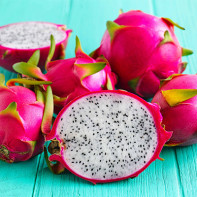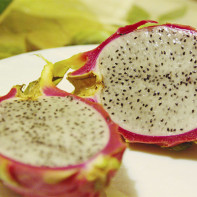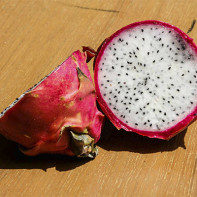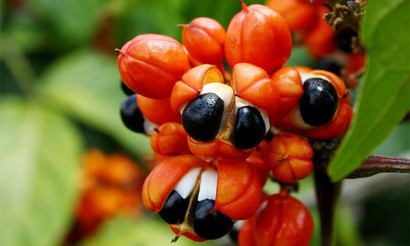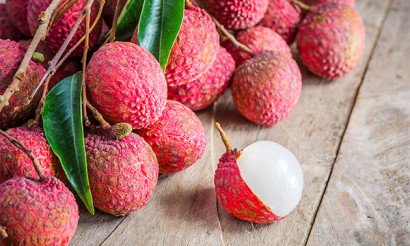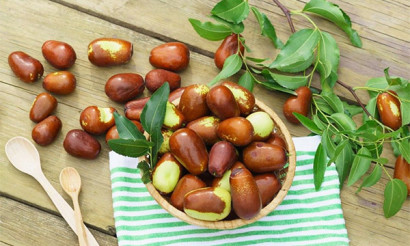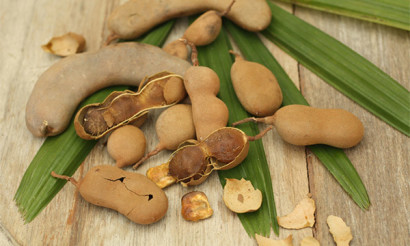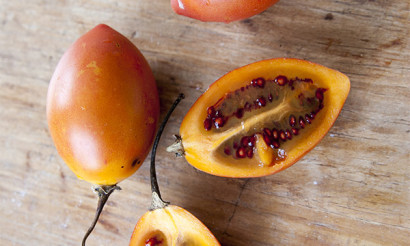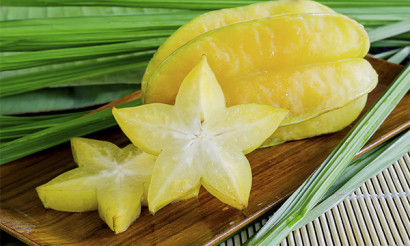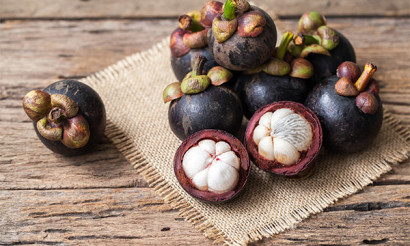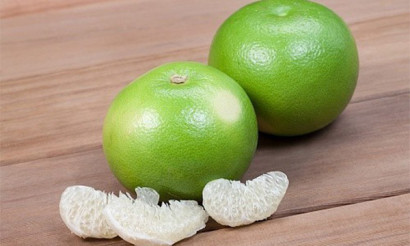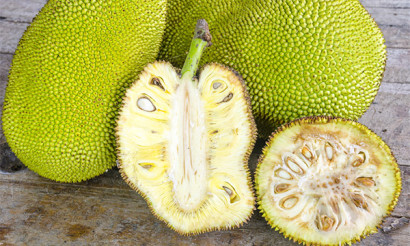Pitahaya: benefits and harms to the body
This plant has many names - pitahaya, pitaya, "dragon fruit." Its fruits do not look too appetizing - they resemble large pink cones. But in fact, the white flesh of these fruits has a rather pleasant taste. And, according to scientific research, it is also very useful.
- What is pitahaya
- Kinds
- How it looks and where it grows
- What Dragon Fruit Taste and Smell Has
- Composition and calorie content
- Health Benefits of Pitahaya Fruit
- General benefit
- For women
- For men
- During pregnancy
- When breastfeeding
- For kids
- When losing weight
- Fruit application
- In medicine
- In cosmetology
- In cooking
- Harm and contraindications
- How to choose and store pitahaya
- How to eat pitahaya
- How to clean
- Is it possible to grow pitahaya at home
- Interesting Facts
What is pitahaya
These fruits look like representatives of an alien flora. But in fact, these are the fruits of plants from the Cactus family. They look unusual. These are creeping plants with aerial roots, more reminiscent of creepers. In length, they can reach 3 m. Some species have soft spines, while others are completely absent. All of them bloom very beautiful large flowers, most often white or cream color.
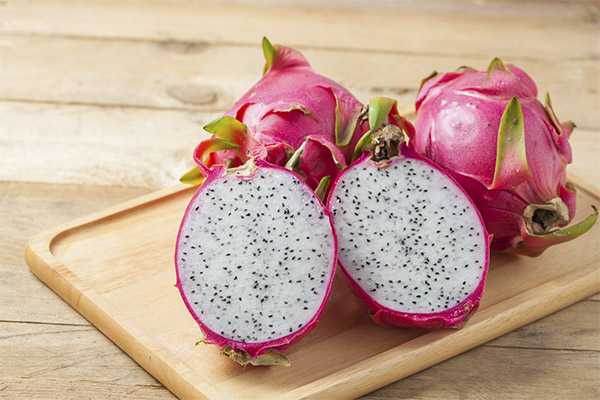
Kinds
There are several types of pitahaya, and they differ not only in shade, but also in taste:
- The Costa Rican pitahaya is the fruit of the Costa Rican cilus Hilocereus, which grows in Guatemala and Peru. It is believed that this variety has the most neutral taste, some define it as fresh or even grassy. These fruits are often used to make salads. In addition, they are well combined with other dishes, but only without a pronounced smell.
- Red pitahaya is the wavy (or sinuous) cactus fruit of the cilus with a brighter skin and flesh. It has the most saturated taste and aroma (compared to other varieties).
- Yellow pitahaya is the fruit of a cactus called large-flowered Hilocereus. It is often cultivated precisely for decorative purposes, since it possesses almost the largest flowers in the entire family. The fruits themselves have a yellow skin, and their flesh is considered the sweetest.
All species have quite juicy pulp. But it should be noted that red pitahaya is less common on sale because it is harder to cultivate.
How it looks and where it grows
The pitaya fruit resembles a bump - it has an elongated shape, often close to an oval. The weight of the fetus can range from 160 to 600 g, but sometimes larger fruits are also found, up to 850 g (and some sources claim that up to 1 kg). The size of the fruit depends on the particular variety and variety, as well as the color of their pulp. The peel of the fruit as a whole is smooth, but characteristic leaf-shaped growths form on it, and outwardly they resemble frozen tongues of fire, which, apparently, was the reason for choosing such a name as a dragon fruit.
Although the fruit of several plants is called a dragon fruit, they all have one thing in common. They grow in regions with an arid tropical climate. For example, pitahaya has long been known in Mexico and Hawaii, is widespread in Southeast Asia, for example China, Thailand, Vietnam, etc. And now it is grown in Israel.
What Dragon Fruit Taste and Smell Has
The taste of this fruit can be described only in comparison with others. If its creamy texture resembles figs (although it does not have such a pronounced aroma), then the taste of the most common varieties can be compared with kiwi. Yellow pitahaya tastes a bit like a banana.
Composition and calorie content
Energy value is low. 100 g of pulp contains only 50 kcal, which makes it one of the most useful dietary products.
As for the chemical composition of the fruits, they contain B vitamins, and specifically:
- Thiamine (B1) is a vitamin that participates in various metabolic processes, improves the body's ability to fight infectious diseases, normalizes the acidity level of gastric juice, and provides intestinal motor function.
- Riboflavin (B2) is one of those vitamins, without which the normal production of hormones is impossible. In addition, it is necessary for good vision, as it protects the retina from the negative effects of sunlight, improves adaptation to the dark.
- Niacin (B3) is a vitamin that is actively involved in lipid and protein metabolism. In addition, it is necessary for the normal functioning of the stomach and pancreas.
As part of this fruit, there is ascorbic acid (vitamin C), which has antioxidant activity. Separately, substances such as betacyanins and betaxanthines should be isolated - they are also antioxidants with pronounced anti-inflammatory properties. The pulp also contains such essential elements as vitamin PP, iron, potassium and phosphorus.
Health Benefits of Pitahaya Fruit
General benefit
Numerous studies have shown that pitahaya is a very healthy fruit, since it has a beneficial effect on the functioning of the cardiovascular and endocrine systems. At the same time, both the pulp of the dragon fruit and its seeds have healing properties. They contain tannins, which are good for vision, so eating pulp and seeds in food is worth at least for the prevention of myopia and farsightedness.
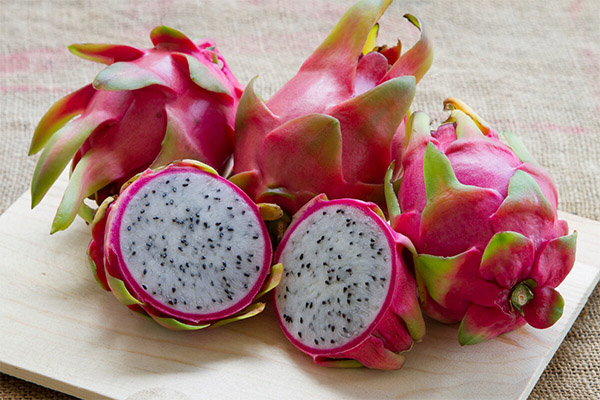
In addition, there are studies that confirm the benefits of dragon fruit in diabetes. Fiber, which is part of it, helps to establish digestion and normalize bowel function.
For women
Pitahaya is often paid attention to because it contains a lot of antioxidants. Indeed, such substances help to significantly slow down the aging process of the body, in particular the appearance of wrinkles. But for women, pitahaya is also beneficial in that it contains a lot of calcium (one fruit contains the daily intake of this substance). And this is very important for women during menopause, since at this time a lack of calcium can lead to the development of osteoporosis.
For men
As you know, antioxidants have, among other things, anti-inflammatory properties. That is why pitahaya is also good for men. The antioxidants contained in its composition are an excellent prophylactic and therapeutic agent against diseases of the prostate gland.
During pregnancy
For future mothers, pitahaya can be useful for several reasons. For example:
- The pulp contains a lot of iron, and this element is necessary for the production of red blood cells (red blood cells). During pregnancy, when a lot of resources are spent on the development of the baby’s body, women experience anemia. Eating pitahaya avoids this problem.
- These fruits contain a lot of folic acid - a vitamin that is necessary for the normal development of the fetal nervous system.
- Fiber contained in the pulp should normalize digestion and eliminate bloating - this is another problem that young mothers face.
However, this product should be used with caution, as it can cause a severe allergic reaction.
When breastfeeding
During lactation, young mothers need vitamins. However, in this case, it is better to refuse pitahaya, since the baby's body can negatively react to any potential allergens, even in more familiar products.
For kids
Being a storehouse of vitamins, pitahaya is very useful for children. But you need to remember that in the same way as all other exotic fruits, it can cause severe allergies. It is generally contraindicated for preschoolers. Children of seven years of age can already give it, but not more than one fetus per day.
When losing weight
It is believed that dragon fruit helps to lose weight.Indeed, the pulp of these fruits contains fiber, which helps to normalize the digestive process, and this is the basis for proper metabolism. In addition, pitahaya contains B vitamins that help speed up metabolism.
This fruit can be used in different ways in dietetics. The most common option is pitahaya-based fasting days. Most often, for this purpose, smoothies are prepared based on this fruit.
For example, in the strawberry season, you can arrange a fasting day on such a smoothie. The flesh of one middle pitahaya fruit, 200 g of fresh strawberries, 30 g of cashew nuts and about 70 ml of coconut milk are taken. All these ingredients are whipped in a blender until a homogeneous mass of sufficiently liquid consistency is obtained. Smoothies are prepared immediately before use. On an unloading day, you can drink three such servings of smoothie, there should be no other food in the diet.
There is another option that can be prepared at any time of the year. For it, you need to take the pulp of one pitahaya fruit, 100 g of peeled pineapple, two medium-sized bananas, a small piece of ginger root (up to 2 cm) and 100 ml of boiled water. Grind all these components in a blender. If the fruits themselves are not very sweet, you can add a little honey to the drink. You can drink no more than three glasses of such a smoothie per day.
Fruit application
Due to its low calorie content and rich vitamin composition, the fruit is used not only in cooking, but also in nutrition, traditional medicine and cosmetology. For example:
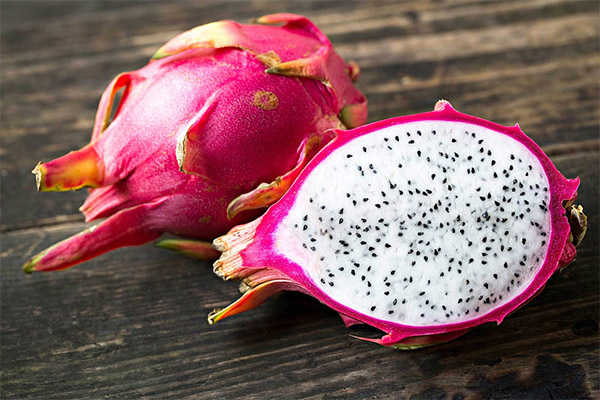
- The pulp of the fruit helps with pain in the stomach, as well as with some diseases of the thyroid gland.
- Fruit juice has not only anti-inflammatory, but also an antimicrobial effect, it can be used to treat any inflammatory processes on the skin. In addition, it is considered effective in the treatment of arthritis.
- Seeds contain a whole range of substances that can improve the condition of people suffering from diabetes.
All parts of the plant are useful. In countries of Southeast Asia, they use both freshly cut stems and flowers (the latter can be brewed with tea).
In medicine
In Russia, pitahaya is not used in official medicine, nor is it used in folk tradition (this is not surprising, because this plant does not grow here). It is used mainly in traditional medicine of the eastern countries, especially popular in Thailand. Here are the options for its use:
- With urolithiasis, it is recommended to make decoctions of flowers (10 g of dry raw materials per glass of boiling water). This remedy has diuretic properties.
- With helminthiasis, decoctions are also made from the flowers and leaves of the plant.
- For arthritis and other inflammatory joint diseases, compresses can be made based on pulp and pitahaya juice or simply include this product in your diet, but not more than 1-2 fruits per day and only after consulting a doctor.
- With burns on the skin, you can prepare a lotion of pitahaya juice, cucumber juice and honey, taken in equal proportions. This tool, as it were, removes heat from the affected area of the skin and greatly facilitates the condition - including that it is also used for sunburn.
- For gastritis in remission, it is recommended to include mashed pulp of one dragon fruit in your diet (it is best to take it once a day on an empty stomach).
Pitahaya fruits are also recommended for liver diseases, enterocolitis, pathologies of the cardiovascular system.
As for the use of pitahaya for diabetes, here doctors do not yet have a consensus on the benefits of the fetus. A number of studies have been conducted that have shown that regular consumption of fruit pulp helps stabilize blood sugar levels in type 2 diabetes. But you need to eat fruit only with seeds. And at the same time, studies have shown that fasting gives the best result, since only in this case can the pancreatic cells that are responsible for the production of insulin be stimulated.
Important: The glycemic index of pitahaya is 25 units.
In cosmetology
Pitahaya is good for benefiting any type of skin.Extracts of this fruit are added under industrial conditions to any caring facial creams. At home, you can make masks for the skin:
- For oily or problematic skin. Beat the fruit pulp in a blender, add 2-3 drops of tea tree essential oil, mix and apply the mixture on the skin of the face, avoiding only the more sensitive area around the eyes. The mask is left for 15-20 minutes, then washed off with cool water or herbal decoction.
- For normal skin. The pulp of one fruit, as in the previous recipe, is whipped in a blender, only the essential oil of rose or any citrus fruit is added. The product is left for 15 minutes, then thoroughly rinsed with mineral water without gas.
- Against acne. Pitaya contains vitamin C, antioxidants and other substances with antimicrobial activity, so it effectively fights acne. To do this, simply cut the fruit into slices and apply them to the affected areas of the skin on the face for literally 15 minutes. Then these pieces are removed, and the face is washed with warm water. To achieve maximum results, the procedure is repeated twice a day, morning and evening.
On the basis of pitahaya, you can also prepare a scrub for the body and face. Moreover, in this case, the seeds themselves should act as an abrasive (i.e. scrubbing) substance. For the face, a finer degree of grinding is recommended. So the pulp and seeds in this case need to be mashed not by hand, but in a blender. If desired, additional ingredients can be added. For example, lemon juice will give a whitening effect.
Pitahaya is also used for hair care. For example, it is believed that her juice will help restore colored curls. You can use one of two recipes for this. For example, you can simply add freshly squeezed juice to the hair conditioner with every wash. This will help cleanse the scalp, saturate the hair follicles with useful substances, and will help restore curls - they will become soft and silky.
The second option is to make a mask once a week. For this, the pulp of one fruit is scooped up with a spoon and crushed in a blender until a homogeneous mass is obtained. The resulting mashed potatoes are applied to the scalp, put on a plastic hat and wrap themselves in a warm terry towel. The product is kept on the skin for 15–20 minutes, then rinsed with ordinary shampoo (but preferably without silicones and parabens). This mask can be enriched with vitamin E by adding one capsule to the mixture, which helps to improve the structure of the hair.
In cooking
Basically, various desserts are prepared from pitahaya, and the fruit is used in its raw form, since heat treatment destroys vitamins in many ways and deprives it of aroma. Moreover, in Thailand, most often pitahaya is used as an independent product, in Vietnam they come up with desserts based on it, and in Indonesia alcoholic drinks with dragon fruit are popular.
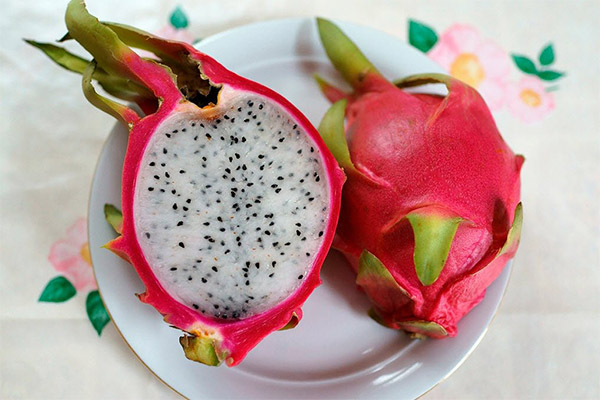
For Russian housewives, pitahaya remains exotic, but you can use not traditional oriental, but modern recipes adapted to European cuisine. For example:
- Fruit salad. For its preparation you will need: 2 pitahaya fruits, 1 mango fruit, 50 g blueberries, ½ kiwi fruit, 3-4 strawberry berries. There are two cooking options. In the first, the fruits of pitahaya and mango are peeled, cut into cubes, and peeled and sliced kiwi are added. All this is decorated with whipped cream and berries. The second option - diced mangoes and slices of kiwi is poured with liquid puree from pitahaya, crushed in a blender, and decorated with berries.
- Sorbet. To prepare it, you will need 2 medium-sized pitahaya fruits, ¾ cup cold purified water, 1 tbsp. spoon of freshly squeezed lemon juice, 2 tbsp. tablespoons of sugar. Pitahaya fruits are peeled, pulp is pulled out, cut into slices, lemon juice, sugar and water are added and beat all this in a blender until a homogeneous consistency. After this, the mixture is frozen so that ice crystals form. The peel from pitaya is not thrown away. They make boats out of it, on which they then lay out the sorbet.
- American dessert with almonds. To prepare, take 2 dragon fruit, 50 g of almonds (you must first chop it), 100 g of soft cream cheese, like the one from which cheesecake is made. The pitaya pulp is cut into cubes, beat the cheese with a whisk, add 2 tbsp. tablespoons of condensed milk, then chopped almonds and cubes of pitaya and mix gently. Dessert is served in dragon fruit peel boats.
- Healthy breakfast. For its preparation, you will need 3 small pitahaya fruits, 2 tbsp. tablespoons of cane sugar, ¾ cup of water, 1 tbsp. spoon goji berries, chia seeds and coconut, 2 tbsp. tablespoons of cereal or granola, any fresh fruit. The pulp of pitaya is crushed in a blender, add water and sugar, put in the freezer for no longer than 15 minutes, then add the rest of the ingredients, mix and serve. You can completely freeze dessert. Then you need to keep the pitaya puree in the freezer until ice crystals form and then decorate with the rest of the ingredients.
Based on pitaya, you can also prepare alcoholic drinks, such as cocktails. For preparation, you will need 1 peeled dragon fruit, 100 ml of vodka, 1 tbsp. spoon freshly squeezed lime juice, 2 tbsp. tablespoons of cane sugar and 50 ml of coconut milk. All this is mixed in a cocktail blender.
Harm and contraindications
Pitahaya, with all its advantages, has one very significant drawback. This is an exotic fruit, and therefore there is a very high risk that it will provoke a strong allergic reaction. Therefore, even if a person has never had an allergy before, he will have to use dragon fruit with caution. That is, first you need to eat a small amount of pulp, and only then, if after a couple of hours no manifestations of allergies occur, you can eat the whole fruit. In principle, in the future it is worth adhering to these restrictions - 1-2 fruits per day, not more.
At the same time, sometimes with the use of red varieties, human urine and its feces can acquire a reddish hue. There is nothing wrong with that, it's just that the body processes natural pigment in such a way.
Young children under the age of 7 should not eat pitahaya at all, as this can lead to the development of diathesis. For the same reason, this fruit should not be included in the diet of pregnant women.
In addition, it should be borne in mind that in people suffering from diarrhea, eating this fruit can significantly aggravate the problem.
How to choose and store pitahaya
It is very important to choose these fruits correctly - only then will they be beneficial. When choosing a pitahaya, you need to focus on the appearance. But since these fruits remain exotic for the Russian market, not everyone knows what they should look like.
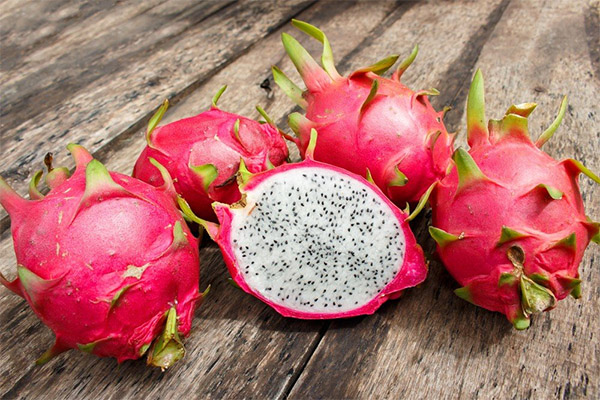
So, although there are several varieties of dragon fruit, its peel should in any case be pink. But the color of the pulp can be different, both white and dark, with a crimson tint. However, there is another unusual variety - the yellow dragon fruit. Its fruits are distinguished by yellow peel and light flesh. Seeds in all of these varieties should be dark and small, like poppy seeds.
You should choose fruits with a bright pink peel, on the surface of which there are no spots. If the peel is too pale, this indicates that the fetus has not yet ripened. If there are dark spots on the surface, the fruit is overripe. In addition, you need to focus on the tips of the growths of "dragon fruit." In ripe fruits, they should be yellowish-green. Dry and withered “scales” indicate that the pitahaya is overripe, and it has been torn for a long time. But if nevertheless such an overripe fruit is caught, it is not worth throwing it away. You can collect seeds from it and grow this cactus at home.
It should also be noted that overripe fruits are always too soft.This can be understood by gently pushing a finger on the fruit. Its surface should only give in slightly - like an avocado. However, if the pitahaya is slightly immature, you just need to hold it in the refrigerator for a couple of days. But do not leave the fruits for a long time. The fresher they are, the more nutrients they have.
You need to store these fruits in the refrigerator, but, unfortunately, these tropical fruits will not be able to lie for a long time even there - a maximum of 5-6 days.
How to eat pitahaya
The main rule here is one - only the pulp of the fruit is eaten. The top layer is considered inedible. Nevertheless, the pitahaya still needs to be washed outside, substituting under running water, after which the fruit is dried with a paper towel. Then it is purified using one of the methods described below. As for the consumption of pulp, there are no strict rules, but, for example, in Thailand it is customary to serve it chilled. In addition, there are very sweet varieties, for Europeans they may even seem cloying, so it is recommended to spray such fruits with lemon juice.
How to clean
There are several ways to get rid of the top layer. For example:
- Pitahaya can be cleaned from the top, as is done with a banana. Then only thick flesh will remain on the plate.
- Cut into slices, like an orange, and peel each individually.
- Cut like kiwi into two halves, and pulp out of each with a spoon.
If you want to use a dragon fruit for a salad, then you need to cut it in half, gently pull out the pulp and cut it into cubes. The peel should not be thrown away. It forms beautiful “boats” that can be filled with fruit cubes cut for salad.
Is it possible to grow pitahaya at home
At home, pitahaya can be grown from those black seeds that are in the white pulp. As already noted, they contain many useful substances and can be used in traditional medicine. But even from them you can grow your own flower.
Pitahaya is, in fact, a cactus, so it will grow well at home. In general, this is an unpretentious plant, so it does not need to create any special conditions. Pitaya loves well-lit areas and warmth, but can withstand a certain drop in temperature (for short periods - up to zero). She will also survive periodic blackouts.
So, for growing at home, you need to collect seeds. Then sprout them in wet gauze. When they sprout, transplant them into a small container with earth and place them on a windowsill in a bright room. While the shoot is only getting stronger, it’s worth organizing a mini-greenhouse by covering the container with plastic wrap. But in general, shoots very quickly get out of the soil and grow quite actively - in a year they can reach a height of 80 cm. All this time the plant needs regular, but at the same time moderate watering. For magnificent flowering, you need to make nitrogen fertilizers. However, it is worthwhile to understand that at home, without pollinating insects, the plant will not bear fruit. Therefore, artificial pollination will have to be applied. To do this, grow at least two copies of pitahaya. They will need to be pollinated with a soft brush at night, because it is then that these magnificent flowers are revealed.
Interesting Facts
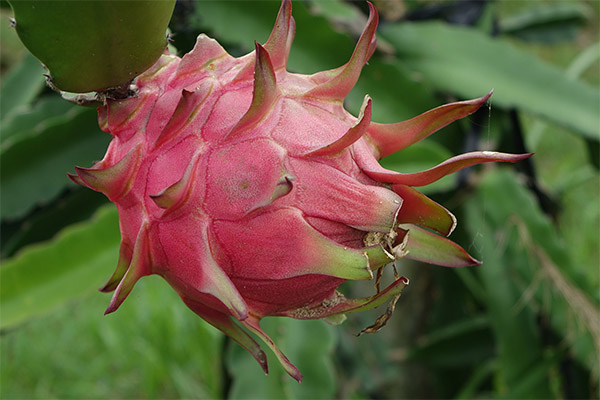
The birthplace of this culture is Central America. It is believed that more than 700 years ago, the pitahaya was familiar to the Aztecs. Europeans met her already in the era of the great geographical discoveries, when the conquistadors tried these fruits. However, it would be very difficult to bring food to Europe in those days, because it has not been stored for a long time. But in 1870, the plant came to France from its overseas colonies. Then they began to grow it to decorate gardens.
Today, pitahaya is grown for export in Vietnam, Nicaragua, Colombia, and is cultivated in Israel for commercial purposes.From 1 ha, you can get a crop of 30 tons per season. Not all of this amount is used for culinary purposes. Stems and flowers are used in the pharmaceutical industry, pulp and peel - in perfumery. In some countries, this plant is also a supplier of raw materials for the alcohol industry - for example, liqueurs are prepared from it.
«Important: all information on the site is provided exclusively in fact-finding purposes. Before applying any recommendations, consult with a profile specialist. Neither the editors nor the authors are liable for any possible harm caused materials. "

